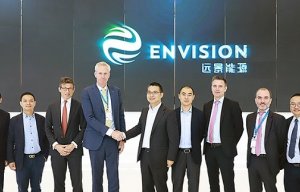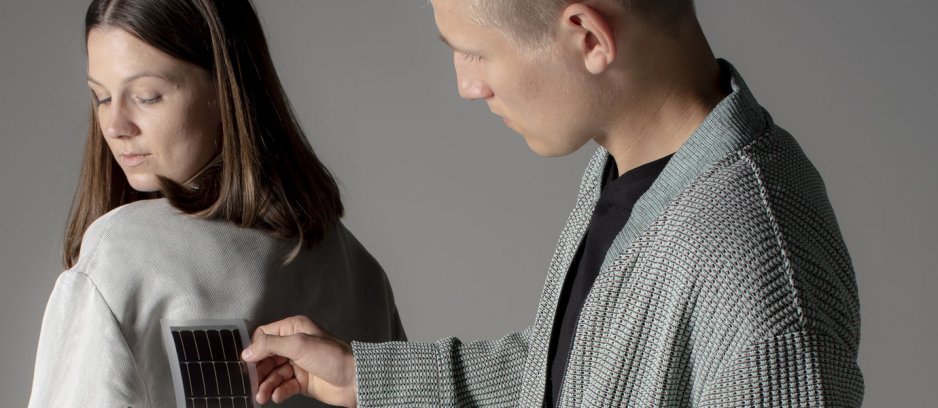
New offshore blade for Envision in China
Solar cells hidden inside fabrics have advantages over those on surfaces, research team finds.

1st June 2022
Innovation in Textiles
|
Finland
Researchers at Aalto University in Finland have developed an invisible, machine-washable solar cell technology for clothing.
The discrete nature of the cells protects them and makes the clothes more attractive, the physics and design researchers say. Promising applications include work and outdoor clothing and curtains which react to changes of light.
In previous studies, solar cells have been installed on the surfaces, layered on top, or woven into the threads of textiles.
During the three-year Sun-powered Textiles project, researchers at the university’s departments of physics and design developed a method of adhering solar cells to textiles in a way that makes them resistant to machine-washing and, at the same time, makes them less of an aesthetic problem. The researchers also took measures to make the solar cell-infused textiles recyclable.
Machine washing
The machine-washability of commercially-available solar cells hasn’t been studied previously to this extent.
“We hypothesised that the solar cell structure might break down in the wash as the cells weren’t designed to be machine-washable,” says Elina Ilén, project specialist at the Aalto University Department of Design. “The washing is a stressful process where the textiles and cells are subject to pressure and collisions, especially during spinning.”
The researchers laminated a solar cell component between textiles in a water-tight polyurethane film. The textiles containing the solar cell component were then washed dozens of times at 40 degrees Celsius. Physics researcher Farid Elsehrawy then measured the output of the solar cells after each round in the washing machine.
Five of the eight samples retained their efficiency, and three lost about 20% of their power. None of the cells or the textiles were damaged during the process.
“Now that the solar cell laminated between textiles has been proved to be machine-washable, we have to protect the rest of the components,” says Janne Halme, university lecturer at the Department of Applied Physics. “Our idea is that all of the electric components of the smart textile could be in the same container with the solar cell. That would give us a machine-washable electronic device that’s embedded in textiles and never needs to have its its battery charged or replaced,”
Lasting power
Any solar cell placed under the textile it adheres to has to have a significantly larger surface area than a cell that’s placed on top. A piece of regular fabric eats up roughly 70% of a cell’s capacity – with a more porous fabric the percentage is smaller.
Key factors in the ability of textiles to let light through them include the material, transparency and crosscut of the fibre, the structure of the threads, the thickness and weave of the fabric, colours and the finish. Light colours transmit better than dark ones, but a pitch-black and completely opaque fabric can also work.
The commercial solar cells used in the study comprised of a single crystal and were made of silicon. They can detect light that is invisible to the naked eye, which is what most of sunlight actually is –infrared, for example.
Hiding the textile eats up some of the solar cell’s power but improves its durability, as it’s better protected from the outside world.
“A cell on the surface also dominates the look of the clothing, turning it into a robot-like piece of armour,” Ilén says. “A cell on the inside makes the product much more visually palatable and affords the opportunity to visually design the product according to the user’s wants and needs,”
Efficient recycling
Researchers used textiles whose fibres were made of only a single material and thus could be recycled as efficiently as possible. Electronic components can be removed from the fabric simply by first applying heat and then tearing them off.
“Previously solar cells have been woven into the textiles as tiny pieces, which is a terrible idea in terms of recycling,” Halme says.
The amount of energy the cells receive depends on their size, quantity and location and is mandated by the end-use application. A crucial aspect is how frequently the application sends data. The most energy-hungry functions include sending information, doing calculations and projecting on screens. That is why solar cells hidden in textiles won’t be enough to charge a smartphone or a smartwatch but are suitable for things like measuring temperature and humidity.
The research team thinks that work clothing has the most for solar cell textiles right now. They are thicker than regular clothes, so the cells have limited impact on the clothing’s look and feel.
“Curtains are another great way to collect solar energy and could detect the amount of light and adjust themselves accordingly,” says Ilén.
The aim of the research project was to develop technical solutions for use in many different applications.
“Solar cells hidden under textiles are also worth considering as energy sources for electrical equipment that, for one reason or another, has to adhere to textiles, look and feel like a fabric, be machine-washable, use as little power as possible, and whose battery is otherwise either too hard or too expensive to charge or replace,” Halme concludes.

Business intelligence for the fibre, textiles and apparel industries: technologies, innovations, markets, investments, trade policy, sourcing, strategy...
Find out more